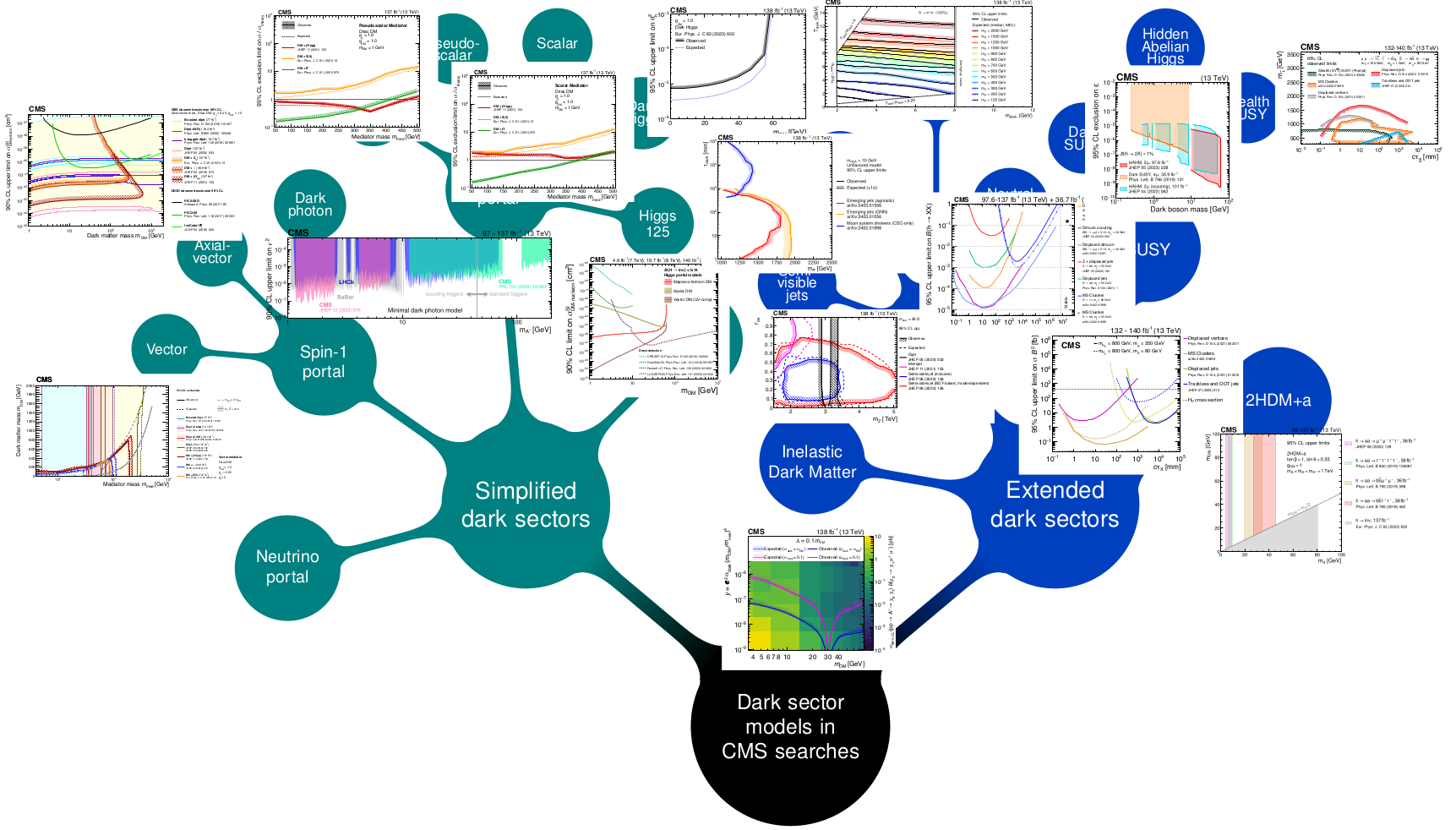
Cosmological observations tell us that Dark Matter makes up roughly 80% of all the matter in the Universe. However, no Dark Matter particle has ever been observed. To verify whether it can be produced in the laboratory, the CMS Collaboration at the Large Hadron Collider has performed over 40 different searches for Dark Matter since 2015. Each of these searches targets different “signatures” of how the Dark Matter would appear in the CMS detector after smashing together protons at the highest energies. Now is the time to take stock and see where we stand! The CMS Collaboration has summarized all of these efforts in a review paper, mapping out the searches performed so far. But it is far more than just a trip down memory lane: in addition to summarizing past results, this paper also provides new interpretations for many of these 40+ results to determine their impact on the latest theoretical models of Dark Matter production.
The CMS Collaboration has probed a variety of theoretical models in these searches for Dark Matter, which can be grouped into different families, as shown in Figure 1. In Dark Matter models, at least one Dark Matter particle is introduced. In addition, there is a “mediator” particle that governs the interaction between the dark particles in the “dark sector” and the particles in the standard model, which are the ones that make up all the visible matter in the universe. As Figure 1 shows, there are two major classes of models used in CMS searches for Dark Matter: “Simplified Dark Sectors”, which involve a single mediator particle, and “Extended Dark Sectors”, which have more complicated structures. Within each of these classes, there are many specific Dark Matter models studied by CMS scientists, including Axion-Like Particles (ALPs), Dark Higgs bosons, Hidden Valleys, particular versions of Supersymmetry (SUSY), and Hidden Abelian Higgs bosons.

Figure 1: A map of the models probed in CMS searches for dark sectors.
Each search for Dark Matter probes a different signature in the detector. In general, these signatures can be “invisible”, “prompt and visible”, or “long-lived”. Invisible signatures arise frequently in searches for Dark Matter because, in its simplest form, Dark Matter should be electrically neutral and not interact in the CMS detector, thus being “invisible” to CMS. However, if we can produce a mediator in the proton collisions, then that means the mediator could also decay into Standard Model particles. This is how “visible” signatures can be sought with CMS data. These signatures can be “prompt” or “long-lived”; some models predict particles that decay immediately and produce “prompt” signatures in the detector, while other models predict particles that travel some distance within the detector before decaying and producing “long-lived” signatures. If the particles have long lifetimes, the CMS scientists must be particularly creative in elaborating the corresponding searches, as these long-lived particles often require special techniques to reconstruct their flight paths within the detector.
For example, new interpretations were performed using “Hidden Valley” theoretical models, which predict multiple new forces and particles that often “hide” in a “valley” and could become accessible at high LHC collision energies. These Hidden Valley models predict several new types of signatures, some prompt, some long-lived, and CMS physicists have now interpreted several existing analyses in these new models. One signature predicted by Hidden Valley models is a “semivisible jet”, in which one jet can contain both visible standard model particles and invisible hidden particles. Three analyses have been now interpreted with this semivisible jet signature, and the results are shown in Fig. 2.

Figure 2: Excluded regions of the Z’ mass-rinv plane from the dedicated semivisible jets search, the dijet search, and the mono-jet search. The hashed areas indicate the direction of the excluded area from the observed limits.
The review paper presents the results of a wide range of searches in CMS for Dark Matter. A summary of these results for the different theoretical models is shown in Fig. 3. Clearly, CMS physicists have investigated a wide range of Dark Matter masses and other intrinsic Dark Matter properties. There has been no sign of Dark Matter yet but this paper helps to map out what has been done and gives physicists important guidance regarding where they should hunt next.

Figure 3: A diagram of how the CMS Dark Matter results map onto the theoretical models used.
Read more about these results:
-
CMS Paper (EXO-23-005): "Dark sector searches with the CMS experiment "
-
@CMSExperiment on social media: LinkedIn - facebook - twitter - instagram
- Do you like these briefings and want to get an email notification when there is a new one? Subscribe here

